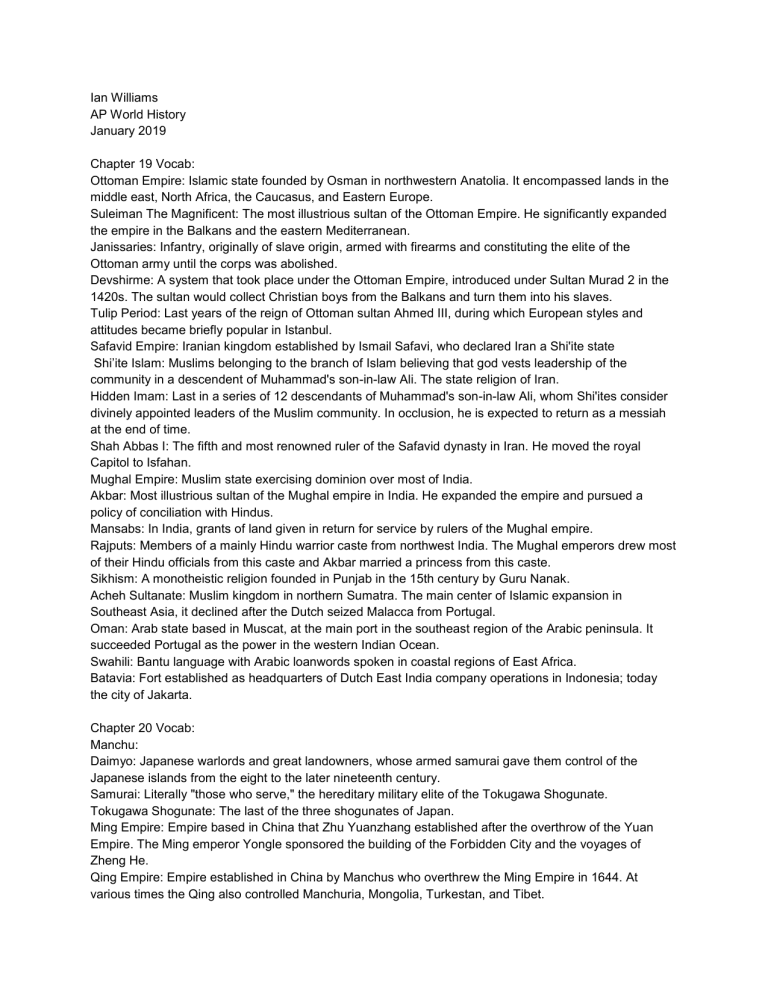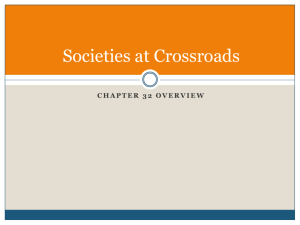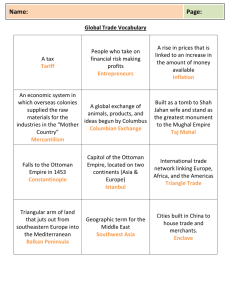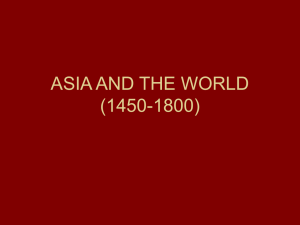APWH Chapter 19-20 Outline
advertisement

Ian Williams AP World History January 2019 Chapter 19 Vocab: Ottoman Empire: Islamic state founded by Osman in northwestern Anatolia. It encompassed lands in the middle east, North Africa, the Caucasus, and Eastern Europe. Suleiman The Magnificent: The most illustrious sultan of the Ottoman Empire. He significantly expanded the empire in the Balkans and the eastern Mediterranean. Janissaries: Infantry, originally of slave origin, armed with firearms and constituting the elite of the Ottoman army until the corps was abolished. Devshirme: A system that took place under the Ottoman Empire, introduced under Sultan Murad 2 in the 1420s. The sultan would collect Christian boys from the Balkans and turn them into his slaves. Tulip Period: Last years of the reign of Ottoman sultan Ahmed III, during which European styles and attitudes became briefly popular in Istanbul. Safavid Empire: Iranian kingdom established by Ismail Safavi, who declared Iran a Shi'ite state Shi’ite Islam: Muslims belonging to the branch of Islam believing that god vests leadership of the community in a descendent of Muhammad's son-in-law Ali. The state religion of Iran. Hidden Imam: Last in a series of 12 descendants of Muhammad's son-in-law Ali, whom Shi'ites consider divinely appointed leaders of the Muslim community. In occlusion, he is expected to return as a messiah at the end of time. Shah Abbas I: The fifth and most renowned ruler of the Safavid dynasty in Iran. He moved the royal Capitol to Isfahan. Mughal Empire: Muslim state exercising dominion over most of India. Akbar: Most illustrious sultan of the Mughal empire in India. He expanded the empire and pursued a policy of conciliation with Hindus. Mansabs: In India, grants of land given in return for service by rulers of the Mughal empire. Rajputs: Members of a mainly Hindu warrior caste from northwest India. The Mughal emperors drew most of their Hindu officials from this caste and Akbar married a princess from this caste. Sikhism: A monotheistic religion founded in Punjab in the 15th century by Guru Nanak. Acheh Sultanate: Muslim kingdom in northern Sumatra. The main center of Islamic expansion in Southeast Asia, it declined after the Dutch seized Malacca from Portugal. Oman: Arab state based in Muscat, at the main port in the southeast region of the Arabic peninsula. It succeeded Portugal as the power in the western Indian Ocean. Swahili: Bantu language with Arabic loanwords spoken in coastal regions of East Africa. Batavia: Fort established as headquarters of Dutch East India company operations in Indonesia; today the city of Jakarta. Chapter 20 Vocab: Manchu: Daimyo: Japanese warlords and great landowners, whose armed samurai gave them control of the Japanese islands from the eight to the later nineteenth century. Samurai: Literally "those who serve," the hereditary military elite of the Tokugawa Shogunate. Tokugawa Shogunate: The last of the three shogunates of Japan. Ming Empire: Empire based in China that Zhu Yuanzhang established after the overthrow of the Yuan Empire. The Ming emperor Yongle sponsored the building of the Forbidden City and the voyages of Zheng He. Qing Empire: Empire established in China by Manchus who overthrew the Ming Empire in 1644. At various times the Qing also controlled Manchuria, Mongolia, Turkestan, and Tibet. Kangxi: Qing emperor (r. 1662-1722). He oversaw the greatest expansion of the Qing Empire. Amur River: This river valley was a contested frontier between northern China and eastern Russia until the settlement arranged in the Treaty of Nerchinsk (1689). Macartney Mission: The unsuccessful attempt by the British Empire to establish diplomatic relations with the Qing Empire. Muscovy: Russian principality that emerged gradually during the era of Mongol domination. The Muscovite dynasty ruled without interruption from 1276 to 1598. Ural Mountains: The north-south range separates Siberia from the rest of Russia. It is commonly considered the boundary between the continents of Europe and Asia. Tsar: From Latin Caesar, this Russian title for a monarch was first used in the sixteenth century. Siberia: The extreme north-eastern sector of Asia, including the Kamchatka Peninsula and the present Russian coast of the Arctic Ocean, the Bering Strait, and the Sea of Okhotsk. Cossacks: Peoples of the Russian Empire who lives outside the farming villages, often as herders, mercenaries, or outlaws. Cossacks led the conquest of Siberia in the sixteenth and seventeenth centuries. Serfs: In medieval Europe, an agricultural laborer legally bound to a lord's property and obligated to perform set services for the lord. In Russia, some serfs worked as artisans and in factories; serfdom was not abolished there until 1861. Peter The Great: Russian tsar (r. 1689-1725). He enthusiastically introduced Western languages and technologies to the Russian elite, moving the capital from Moscow to the new city of St. Petersburg. Chapter 19 Outline: Southwest Asia and The Indian Ocean, 1500-1750: I: The Ottoman Empire, To 1750: 1: Expansion and Frontiers: The Ottoman Empire began as a small state in northwest Anatolia and succeeded largely due to their strategic hold on the Dardanelles straight. Suleiman the Magnificent led one of the greatest assaults on Christian Europe, ousting groups like the Knights of the Hospital of St. John. The Ottomans also gained control of the Red Sea, helping to regulate trade and controlling many of the ports. 2: Central Institutions: The military traditions for the Ottomans originally came from the Turkishhorseback riders and their early military tactics and weapons reflected this. The Ottomans also used Janissaries or converted troops who trained year round and fought on foot using guns. 3: Crisis of The Military State, 1585-1650: The Ottoman Empire had a hard time paying for all of the new military technology that they were using in their army. Inflation was also a huge problem. 4: Economic Change and Growing Weakness, 1650-1750: While the Ottoman Empire was struggling with economic and military weakness, the Sultan retreated into the palace and stayed there. The failing state was forced to enact very high taxes and the normal commodities that the people were used to soon disappeared. II: The Safavid Empire, 1502-1722: 1: The Rise of The Safavids: The rise of the Safavids began with Timur’s successor, Ismail. He declared himself Shah of Iran and declared that his kingdom was to practice Shi’ite Islam. 2: Society and Religion: The fact that Ismail converted his state to Shi’ite created a deep groove of frustration between the people of Iran and their neighboring countries, as the neighboring countries were mostly Sunni. 3: A Tale of Two Cities: Isfahan and Istanbul: Religious traditions varied too from place to place, although it was mostly the same within one sect. The architecture style was very similar too. 4: Economic Crisis and Political Collapse: The Safavids faced the same problems that the Ottomans had to face. Their economy wasn’t particularly strong, as their manufacturing skills were very poor and very few people wanted to be part of the agricultural community. III: The Mughal Empire, 1526-1761: 1: Political Foundations: The founder of the Mughal Empire was named Babur, and he was a descendant of Timur. Technically the word Mughal means Mongol, but the population traced its heritage to the Turks. 2: Hindus and Muslims: The Hindus had been long repressed by the Muslims in India, where the Muslims would destroy Hindu temples, monuments, and force conversion among the people. However, the Hindus had never before been able to organize themselves before and raise up against the Muslims. 3: Central Decay and Regional Challenges, 1707-1761: IV: The Maritime Worlds of Islam, 1500-1750: 1: Muslims In Southeast Asia: It is not clear exactly when and how Islam spread in Southeast Asia. It appears that conversion and the formation of Muslim communities began in port cities and royal courts in the fourteenth century and was transmitted to the countryside by itinerant Sufis. 2: Muslims In Coastal Africa: The Muslim-ruled port cities of the Swahili Coast were not well connected with each other, nor did they have much contact with the people of their dry hinterlands. Cooperation was hindered by the thick bush country that separated the tracts of coastal land and by the fact that the cities competed with each other for trade. 3: European Powers In Southern Seas: The better-organized Dutch drove the Portuguese out of the Malacca in 1641, conquered local kingdoms on Sumatra and Java, and established a colonial capital at Batavia (now Jakarta). Chapter 20 Outline: Northern Eurasia, 1500-1800: I: Japanese Reunification: 1: Civil War and The Invasion of Korea, 1500-1603: During the 12th century, the Japanese islands were split apart in a feudal fashion.There was daimyo who ruled over their areas of land and who had their own systems of defense, government, bureaucracy, and taxation. 2: The Tokugawa Shogunate, to 1800: The Japanese were able to unite and create a centralized government the Tokugawa Shogunate, established by a shogun named Tokugawa Ieyasu. He set up the capital at now-day Tokyo, and the road between Tokyo and Kyoto (the imperial capital) led to Japan’s economic growth. 3: Japan and The Europeans: Japan had a mixed reaction to their interactions with the Europeans. TheJapanese walked away with the first gunpowder revolution, realizing how important it was in their military. 4: Elite Decline and Social Crisis: During the 1700s, the Tokugawa dynasty was on the decline. The growing rate of people far surpassed the rate of growth and development leading to the underdevelopment of rural areas and over the development of more central areas. II: The Later Ming and Early Qing Empire: 1: The Ming Empire, 1500-1644: The Ming dynasty was marked by great economic and social growth within the dynasty. The Chinese were incorporated into the global economy after the advent of the production line led to an increase in manufactured goods that were demanded all throughout Europe. 2: Ming Collapse and The Rise of The Qing: The Ming collapsed largely due to their instability due to the large revolts taking place within the dynasty. This huge instability took troops away from the borders leaving them insecure and vulnerable to attack. With the military stretched thin and the internal state in a state of warfare, the Ming dynasty was extremely unstable. 3: Trading Companies and Missionaries: The trade in China was very limited at first but late opened up, allowing certain charter companies and countries to trade and missionaries to spread and preach in China. The Jesuits became especially influential in their mission, learningConfucianism values, and the Chinese language. 4: Emperor Kangxi: The reigns of the Kangxi Emperors were ones of great posterity in economics, military, and cultural achievements. The Emperors pushed public works projects like waterworks and repairing roads, and establishing economic incentives for people to move to underdeveloped areas. 5: Chinese Influences on Europe: The Chinese not only received ideas from Europe, but they also gave them as well. TheChinese shared their scientific ideas like the medical idea of inoculation to prevent the spread of smallpox. 6: Tea and Diplomacy: The Europeans also had a high demand for Asian products. Things like silk, tea, and wallpaper were highly coveted and demanded items in Europe. The Chinese also shared their philosophy system with the Europeans, and their poems were popular in the Europe states. 7: Population and Social Stress: Overpopulation became a huge problem in China towards the end of the Qing dynasty. There were more people, which meant that there were less available land per family and less land for farming. III: The Russian Empire: 1: The Drive Across Northern Asia: The Russian people were a group of Slavic people who could trace the origin of their religion to the Greek people, as the Russians were mostly OrthodoxChristians. The Mongols of the Golden Horde had ruled over them for over 200years and made Moscow the political center of Russia. 2: Russian Society and Politics To 1725: Because of the large expansions made by the Russian Empire, new cultures, religions, and languages were incorporated into the Russian Empire. The language barrier was fairly easy to overcome, but the religion and culture difference created tensions between the Russians and the conquered peoples. 3: Peter The Great: Peter the Great was a Tsar who ruled from 1689-1725. Peter helped to end Russia isolation and turn Russia’s trading and cultural influence towards Europe instead of Asia. 4: Consolidation of The Empire: Russia’s expansion eastward was motivated by the search for resources like furs, which were highly coveted by the Europeans and Americans.



